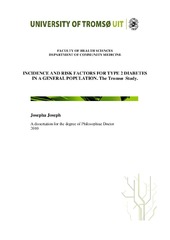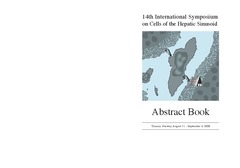Indiciense and risk factors for type 2 diabetes in a general population : the Tromsø Study
Permanent link
https://hdl.handle.net/10037/2968View/
Thesis introduction and appendixes (PDF)
Josepha Joseph, Johan Svartberg, Inger Njølstad and Henrik Schirmer: 'Risk factors for type 2 diabetes in groups stratified according to metabolic syndrome: a 10-year follow-up of The Tromsø Study',Eur J Epidemiol (2010) 26:117-124. (PDF)
Date
2011-01-28Type
Doctoral thesisDoktorgradsavhandling
Author
Joseph, JosephaAbstract
Hovedfokus for denne avhandlingen var å avklare betydningen v forskjellige risikofaktorer for type 2 diabetes i Tromsøundersøkelsen. Den baserer seg på 11 års oppfølging fra 1994 til 2005. Utvalget besto av 26093 personer (12398 menn og 13695 kvinner) som deltok i Tromsøundersøkelsen i 1994/1995. Av disse ble 7060 screenet igjen i 2001 og 10102 i 2008. Hovedfunnene i avhandlingen var;
(1) I en oppfølgingstid på 11 år ble det funnet 492 validerte nye tilfeller av type 2 diabetes, hvorav 294 blant menn og 198 blant kvinner; (2) Alder, Kroppsmasseindeks (KMI), triglycerider, HDL kolesterol, hypertensjon, familiehistorie med diabetes, lav utdannelse og røyking var alle uavhengige predictorer for type 2 diabetes i begge kjønn. Tillegg var også total-kolesterol og fysisk inaktivitet uavhengige prediktorer i menn; (3) Personer med type 2 diabetes hadde ugunstige nivå av HDL kolesterol, triglycerider, KMI og hypertensjon både ved start og slutt av 14 års oppfølging. Selv om det var en økning i både antihypertensiv og kolesterolsenkende behandling hos personer med type 2 diabetes, var det kun 50% som oppfylte minst ett behandlingsmål. Dette kan være en forklaring på hvorfor hjerteinfarktpasienter med diabetes har en dårligere langtidsoverlevelse enn pasienter uten diabetes; (4) Ved å benytte kriterier på metabolisk syndrom til å identifisere kommende pasienter med type 2 diabetes fanget vi mindre enn 50% av de som utviklet sykdommen. Det er derfor viktig å benytte et videre spekter av risikofaktorer for tidlig identifisering av personer med høy risiko for type 2 diabetes. Vi anbefaler i tillegg til å benytte KMI, inaktivit og alder også å inkorporere røyking og ikke-fastende triglycerider (en tidlig markør på insulin resistens) i disse risikoskårene. The main aim of this thesis was to explore different risk factors for type 2 diabetes in the population of Tromsø. This is a prospective study with 11 years follow up from 1994 to 2005 of 26093 subjects, (12398 men and 13695 women), who attended the fourth Tromsø survey. Of these, 7191 subjects were rescreened in 2001 and 10327 subjects in 2007/8, enabling us to analyse change in risk factors. The main findings of this thesis were;
(1) A total of 492 validated cases of incident type 2 diabetes were detected during the 11 year follow-up, 294 among men and 198 among women; Giving an incidence of 2,6/1000 person years and 1,6/1000 person years, for men and women respectively. (2) Age, BMI, triglycerides, HDL cholesterol, hypertension, family history of diabetes, low education and smoking were independent predictors of type 2 diabetes in both genders with an addition of total cholesterol and lack of physical activity in men; (3) Unfavourable levels of HDL cholesterol, triglycerides, BMI, and hypertension were seen in diabetes cases during 14 years of follow-up. Despite in increase in both antihypertensive and cholesterol lowering treatment among people with diabetes, national treatment targets were met in less than 50% of subjects. This might explain why case fatality rates of myocardial infarction are higher over a long term in patients with type 2 diabetes than in those without. (4) The use of metabolic syndrome criteria failed to detect more than 50% of subsequent cases of type 2 diabetes. Therefore screening tools acknowledging a wider range of risk factors need to be adopted in early detection of high risk subjects to enable prevention of the disease. We suggest in addition to BMI, physical inactivity and age to incorporate smoking and non-fasting triglycerides (as an early marker of insulin resistance) in these risk scores.
Key words: : type 2 diabetes, gender, risk factors, BMI, lipids, family history, education, physical activity, smoking, metabolic syndrome.
Description
Papers 1 and 2 are not available in Munin:
1. Josepha Joseph, Johan Svartberg, Inger Njølstad and Henrik Schirmer: 'Incidence of and risk factors for type-2 diabetes in a general population: The Tromsø Study', Scandinavian Journal of Public Health, 2010; 38: 768–775 (Sage - publisher's restrictions). Available at http://dx.doi.org/10.1177/1403494810380299
2. Josepha Joseph, Johan Svartberg, Inger Njølstad, Henrik Schirmer.: 'Change in cardiovascular risk factors in relation to diabetes status. The Tromsø Study.' (Unpublished manuscript)
1. Josepha Joseph, Johan Svartberg, Inger Njølstad and Henrik Schirmer: 'Incidence of and risk factors for type-2 diabetes in a general population: The Tromsø Study', Scandinavian Journal of Public Health, 2010; 38: 768–775 (Sage - publisher's restrictions). Available at http://dx.doi.org/10.1177/1403494810380299
2. Josepha Joseph, Johan Svartberg, Inger Njølstad, Henrik Schirmer.: 'Change in cardiovascular risk factors in relation to diabetes status. The Tromsø Study.' (Unpublished manuscript)
Publisher
Universitetet i TromsøUniversity of Tromsø
Series
ISM skriftserie, nr 113Metadata
Show full item recordCollections
- Doktorgradsavhandlinger (Helsefak) [770]
- ISM skriftserie [161]
Copyright 2011 The Author(s)
The following license file are associated with this item:
Except where otherwise noted, this item's license is described as Attribution-NonCommercial-ShareAlike 3.0 Unported (CC BY-NC-SA 3.0)
Related items
Showing items related by title, author, creator and subject.
-
Influence of environmental tonicity changes on lipophilic drug release from liposomes
Nikolaisen, Trygg Einar (Mastergradsoppgave; Master thesis, 2018-05-15)Introduction: Liposomes as drug delivery systems has been widely studied as a way to solubilize poorly soluble drugs, reduce side effects of chemotherapeutics and increase circulation time in vivo. Since the first descriptions of liposomes over 60 years ago, they have shown tendencies to shrink and swell when the external environment of the liposomes is altered. This phenomenon has been studied in ... -
Prognostic Impacts of Angiopoietins in NSCLC Tumor Cells and Stroma : VEGF-A Impact Is Strongly Associated with Ang-2
Andersen, Sigve; Dønnem, Tom; Al-Shibli, Khalid Ibrahim; Al-Saad, Samer; Stenvold, Helge; Busund, Lill-Tove; Bremnes, Roy M. (Journal article; Tidsskriftartikkel; Peer reviewed, 2011)Angiopoietins and their receptor Tie-2 are, in concert with VEGF-A, key mediators in angiogenesis. This study evaluates the prognostic impact of all known human angiopoietins (Ang-1, Ang-2 and Ang-4) and their receptor Tie-2, as well as their relation to the prognostic expression of VEGF-A. 335 unselected stage I-IIIA NSCLC-patients were included and tissue samples of respective tumor cells and ... -
14th International Symposium on Cells of the Hepatic Sinusoid
Smedsrød, Bård (Book; Bok, 2008-08-31)Abstract book of the symposium


 English
English norsk
norsk



